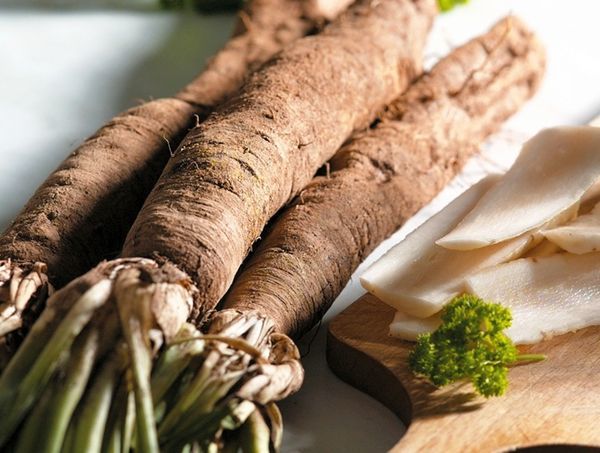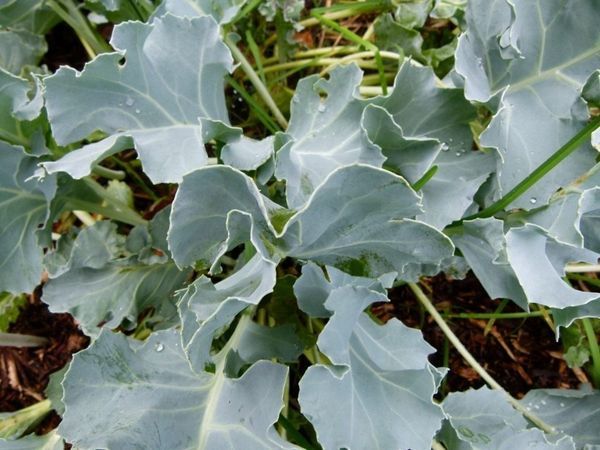Katran is the name that many people hear for the first time, but those who have already started growing this plant have managed to love it. It turns out that this is the “sibling” of the familiar and such widespread garden horseradish. In the wild form is found in the steppes of the Crimea, therefore, received the name "Crimean steppe horseradish."
Table of contents
- What is a steppe horseradish
- Areas of application
- Cultivation technology
- Plant care
- Harvesting and storing crops
What is a steppe horseradish
Katran is a herb of the cruciferous family. His closest "relatives" - cabbage, radish, radish, turnip, horseradish. Thanks to 's high resistance to frost and drought, is a perennial crop, although many gardeners grow it as a biennial plant.
The plant very loves the open spaces of the , lit by the bright sun, and absolutely does not tolerate the blackening of the .
In the first year, the plant forms a spreading rosette of wide, large leaves with a height of 60-120 cm. From the second year it begins to bloom and give seeds, increasing the number of leaves.
The plant may well serve as a home garden decor, since luxurious white or pink inflorescences remain on the bushes for a very long time, emitting a strong honey aroma and actively attracting pollinating insects.
 The root of the steppe horseradish katran
The root of the steppe horseradish katran Root katrana rod, goes deep into the soil, very juicy, fleshy , brittle, the flesh is pale cream color. In terms of taste and useful qualities, it practically does not differ from garden horseradish, but is much more fruitful: in one year it gives an even, powerful, juicy core with a diameter of 1.5–5 cm and a length of 20-60 cm.
Applications
Katran - is much tastier and much richer in chemical composition than horseradish. Both leaves and rhizomes, which more than contain protein, fats, phytoncides( bioactive substances that kill bacteria), essential oils, mineral salts, starch, pectin, inulin, nicotinic acid, carotene, vitamins C, B1, B2, are suitable for food.
Young green fleshy and juicy leaves are eaten just like a salad or asparagus. Spicy spicy taste and characteristic odor due to the content of essential oil.
Root vegetables taste very similar to horseradish, but more juicy and tasty. It is consumed fresh for preparing shredded table horseradish, sauces, in canning or salting vegetables. Still, unlike horseradish, chopped roots can be boiled and baked.
 Green leaves of katran are also used in food.
Green leaves of katran are also used in food. The plant has the ability of to remove salts from the body of .
Here is one of the medical recipes: grind 1 kg of katran rhizomes in a meat grinder, add 4 liters of cold water, bring to a boil, cook over low heat for 5 minutes. Strain the mixture, add a pound of honey. Store the finished medicinal substance in the refrigerator, use 1 glass a day. The course is repeated 2 times a year. - in spring and autumn.
Cultivation technology
The plant is quatran responsive to fertile, rich sandy-sand neutral soils .In the acidified soil during the digging make ashes( 300-500g per 1 sq. M).
Garden beds are deeply dug, they make humus, fertilize with superphosphate, add potassium salt( 50g per 1 sq. M).
Seeds take no less than pea, as small seeds do not germinate.
 Seeds of katran
Seeds of katran Are sown in the soil immediately before the onset of frost at a depth of 2-3 cm according to the scheme: between plants - 20-30 cm , 50-60 cm .When sowing in the fall, seed stratification is not carried out( in the winter they undergo quenching naturally), germinate at t 3-4 degrees, and seedlings easily tolerate frosts to t-5-6 degrees.
If seeds are sown in spring, they should go through stratification for 90-100 days: calibrated seeds are soaked, then mixed with sand and stored in snow or in a refrigerator at a temperature of 0-10 degrees until sowing.
Rassadny way can also be grown katran. For this, seedlings at the age of 35-45 days with a rosette of 4-5 leaves are planted in a permanent place. The length of the root should be at least 20 cm, should be planted with a peg. But the quality of the root with this method of cultivation is much worse, and the method itself is rather laborious.
Plant care
The main care is timely loosening the soil, weeding and removing weeds. In the first year of cultivation in the stage of 2-3 true leaves, they cut through the quatrans, leaving the strongest shoots at a distance of 30-40 cm from each other.
In the second year in early spring, the soil is harrowed or weeded( loosened) and watered regularly. For 2-3 years of life, the katran blooms, forms fruits in the form of a pod with one seed.
 Flowering begins at 2-3 years of life.
Flowering begins at 2-3 years of life.  Katran can grow in one place for 10-15 years
Katran can grow in one place for 10-15 years If the root is not scooped up and only leaves are used for food, then can grow in one place for 10-15 years .
Harvesting and storage of the crop.
. The Qatran harvest is carried out in the second - third year of the growing season of the plant in late autumn. The rhizomes in this period reach a length of 50-60 cm, in order not to damage them, they are broken in with garden forks or staples. Good root crops in diameter reach 5-8 cm. They are fairly well stored in the basement( can be stored in the sand) or in the refrigerator.
Katran - unpretentious and useful plant. As a drug used to improve digestion, disorders of the gastrointestinal system, hot sauces and grated seasonings - an excellent prophylactic against colds.
The long range of advantages and useful properties of this culture make it increasingly popular among gardeners and stimulate their cultivation.


